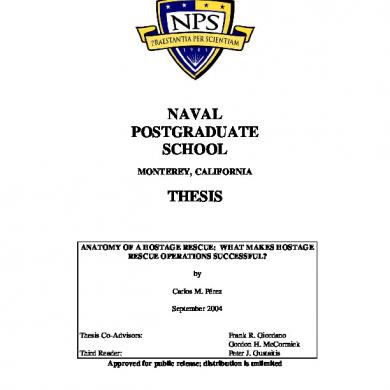Qualitative Risk Analysis
This document was uploaded by user and they confirmed that they have the permission to share it. If you are author or own the copyright of this book, please report to us by using this DMCA report form. Report DMCA
Overview
Download & View Qualitative Risk Analysis as PDF for free.
More details
- Words: 770
- Pages: 3
Loading documents preview...
Qualitative Risk Analysis Qualitative risk analysis includes methods for prioritizing the identified risks for further action, such as risk response. The PRMT can improve the project’s performance effectively by focusing on high‐ priority risks. g
Team members revisit qualitative risk analysis during the project’s lifecycle. When the team repeats qualitative analysis for individual risks, trends may emerge in the results. These trends can indicate the need for more or less risk management action on particular risks or even show whether a risk mitigation plan is working.
Risk Assessment Qualitative risk analysis for all projects levels (minor, moderate, major and mega) assigns a Probability and an Impact to each risk in the risk register. The Overall Rating will automatically calculate and determine where the greatest effort should be focused in responding to the risks. They facilitate structured risk response action and resource allocation. The three ratings for projects are:
“High” – First priority for risk response. “Medium” – Risk response as time and resources permit. “Low” – No risk response required at this time.
Qualitative risk analysis includes methods for prioritizing the identified risks for further action, such as risk response. The PRMT can improve the project’s performance effectively by focusing on high‐priority g risks. Team members revisit qualitative risk analysis during the project’s lifecycle. When the team repeats qualitative analysis for individual risks, trends may emerge in the results. These trends can indicate the need for more or less risk management action on particular risks or even show whether a risk mitigation plan is working. Qualitative risk analysis for Moderate projects assesses the priority of identified risks using their probability of occurring and the corresponding impact on project objectives if the risks occur.
Probability and Impact Ratings for Projects Table 5 lists an example of definitions of risk probability and impact ratings. The cost impact ratings may be easier to apply if expressed in terms of dollars. The ratings for the project serve as a consistent frame of reference for the PRMT in assessing the risks during the life of the project. The table is intended as a guide – the PRMT may define dollar and time ranges as appropriate for the project. The impacts are to the overall project. Schedule delay applies to risks that are on the critical path (the longest path). During the Planning and Design phase, delay impacts to the letting date may be of primary interest. During construction, delays impact project completion.
TABLE 5 –DEFINITIONS OF IMPACT AND PROBABILITY RATINGS Rating -->
Very Low
Low
Moderate
High
Very High
Insignificant
<5% cost
5‐10% cost
10‐20% cost
>20% cost
cost increase
increase
increase
increase
increase
<1% cost
1‐3% cost
3‐5% cost
>5% cost
Cost Impact of Threat (CO + COS) Cost Impact of Opportunity (CO + COS) Schedule Impact of Threat Schedule Impact of
Insignificant cost
decrease
decrease
decrease
decrease
reduction Insignificant
<1 month
1‐3 months
3‐6 months
>6 months
slippage
slippage
slippage
slippage
slippage
Insignificant
<1 month
1‐2 months
2‐3 months
>3 months
improvement
improvement
improvement
improvement
improvement
1–9%
10–19%
20–39%
40–59%
60–99%
Opportunity Probability
Performing Qualitative Risk Analysis The PRMT assesses each identified risk in turn and assesses:
The rating for the probability of the risk occurring, and The rating of cost and time impact of each risk, should it occur.
For a particular impact, the combination of the probability rating of the risk occurring and the impact rating positions the risk into one of the three colored zones in the risk matrix. The color of the zone indicates the priority of the risk for risk response: red zone signifies high importance, yellow is medium importance, and green is low importance. For example, a risk having a “Moderate” probability and a “High” impact falls into the red zone. Its impact score is 3 x 8 =24.
5‐3 Entering Assessments into the Risk Register The qualitative risk analysis of each risk is entered into the risk register.
Column
Contents
Probability Cost Impact Time Impact
Select the probability level from the drop‐down list. Select the cost impact level from the drop‐down list. Select the time impact level from the drop‐down list.
The “Cost Score” is equal to the Probability number times the Cost Impact number. The “Time Score” is equal to the Probability number times the Time Impact number. The risks in a colored zone may be further prioritized for risk response according to their Cost and Time Scores. The higher the score, the higher the priority for risk response and monitoring. Other columns in the risk register will be completed or updated by the risk response process in Chapter 7.
Team members revisit qualitative risk analysis during the project’s lifecycle. When the team repeats qualitative analysis for individual risks, trends may emerge in the results. These trends can indicate the need for more or less risk management action on particular risks or even show whether a risk mitigation plan is working.
Risk Assessment Qualitative risk analysis for all projects levels (minor, moderate, major and mega) assigns a Probability and an Impact to each risk in the risk register. The Overall Rating will automatically calculate and determine where the greatest effort should be focused in responding to the risks. They facilitate structured risk response action and resource allocation. The three ratings for projects are:
“High” – First priority for risk response. “Medium” – Risk response as time and resources permit. “Low” – No risk response required at this time.
Qualitative risk analysis includes methods for prioritizing the identified risks for further action, such as risk response. The PRMT can improve the project’s performance effectively by focusing on high‐priority g risks. Team members revisit qualitative risk analysis during the project’s lifecycle. When the team repeats qualitative analysis for individual risks, trends may emerge in the results. These trends can indicate the need for more or less risk management action on particular risks or even show whether a risk mitigation plan is working. Qualitative risk analysis for Moderate projects assesses the priority of identified risks using their probability of occurring and the corresponding impact on project objectives if the risks occur.
Probability and Impact Ratings for Projects Table 5 lists an example of definitions of risk probability and impact ratings. The cost impact ratings may be easier to apply if expressed in terms of dollars. The ratings for the project serve as a consistent frame of reference for the PRMT in assessing the risks during the life of the project. The table is intended as a guide – the PRMT may define dollar and time ranges as appropriate for the project. The impacts are to the overall project. Schedule delay applies to risks that are on the critical path (the longest path). During the Planning and Design phase, delay impacts to the letting date may be of primary interest. During construction, delays impact project completion.
TABLE 5 –DEFINITIONS OF IMPACT AND PROBABILITY RATINGS Rating -->
Very Low
Low
Moderate
High
Very High
Insignificant
<5% cost
5‐10% cost
10‐20% cost
>20% cost
cost increase
increase
increase
increase
increase
<1% cost
1‐3% cost
3‐5% cost
>5% cost
Cost Impact of Threat (CO + COS) Cost Impact of Opportunity (CO + COS) Schedule Impact of Threat Schedule Impact of
Insignificant cost
decrease
decrease
decrease
decrease
reduction Insignificant
<1 month
1‐3 months
3‐6 months
>6 months
slippage
slippage
slippage
slippage
slippage
Insignificant
<1 month
1‐2 months
2‐3 months
>3 months
improvement
improvement
improvement
improvement
improvement
1–9%
10–19%
20–39%
40–59%
60–99%
Opportunity Probability
Performing Qualitative Risk Analysis The PRMT assesses each identified risk in turn and assesses:
The rating for the probability of the risk occurring, and The rating of cost and time impact of each risk, should it occur.
For a particular impact, the combination of the probability rating of the risk occurring and the impact rating positions the risk into one of the three colored zones in the risk matrix. The color of the zone indicates the priority of the risk for risk response: red zone signifies high importance, yellow is medium importance, and green is low importance. For example, a risk having a “Moderate” probability and a “High” impact falls into the red zone. Its impact score is 3 x 8 =24.
5‐3 Entering Assessments into the Risk Register The qualitative risk analysis of each risk is entered into the risk register.
Column
Contents
Probability Cost Impact Time Impact
Select the probability level from the drop‐down list. Select the cost impact level from the drop‐down list. Select the time impact level from the drop‐down list.
The “Cost Score” is equal to the Probability number times the Cost Impact number. The “Time Score” is equal to the Probability number times the Time Impact number. The risks in a colored zone may be further prioritized for risk response according to their Cost and Time Scores. The higher the score, the higher the priority for risk response and monitoring. Other columns in the risk register will be completed or updated by the risk response process in Chapter 7.
Related Documents

Qualitative Risk Analysis
January 2021 1
L04 Qualitative Risk Analysis
January 2021 1
Lightning System And Risk Analysis Study
January 2021 1
Research. Science Of Qualitative
January 2021 9
Country Risk
January 2021 1
Health Risk
February 2021 1More Documents from "Nazbun Bin Ghazi"

Qualitative Risk Analysis
January 2021 1
Anatomy Of A Hostage Rescue - Ada427693
January 2021 2
Manual De Acupunctura
February 2021 3
Esquema Opo.pdf
January 2021 1
